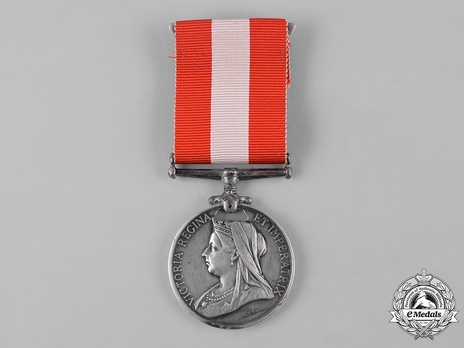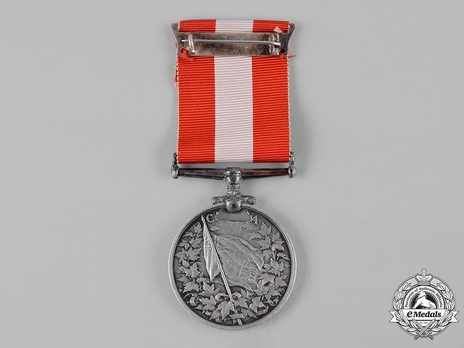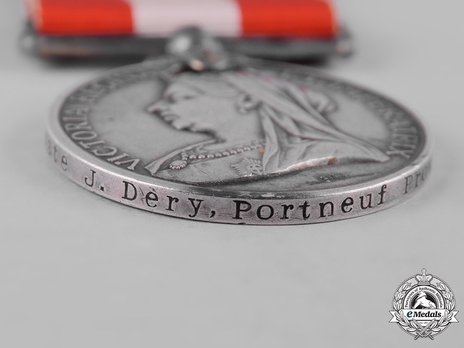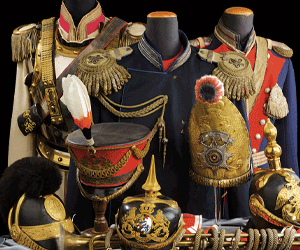Canada General Service Medal
SKU: 02.GBR.0188.500.01
Estimated market value:



Estimated market value:
Attributes
Physical Description
A circular medal constructed of silver, the obverse center bears the left facing side portrait of Queen Victoria in a veil wearing the Order of the Garter, encompassed by VICTORIA REGINA ET IMPERATRIX, below the bust is the initials T.B. (Thomas Brock), the reverse bears an image of the Canadian Red Ensign encompassed by an open-ended wreath of maple leaves tied with a ribbon at the bottom, above the flag is the word CANADA, measuring 36mm (diameter),with a plain, straight swivelling suspension, on a red, white and red ribbon (representing Canada).
History
The Canadian General Service Medal was authorized on January 1, 1899. The medal was awarded to members of the Imperial and Canadian forces for duties relating to the Fenian Raids of 1866 and 1870 and the Red River Rebellion of 1870 (also known as Riel’s Rebellion). Members of the Imperial and Canadian forces who served during those battles had to apply for the medal and the application date was extended to 1907 and then to 1928. The original order gave approval to the Canadian government to issue the medal, however, it was produced by the Royal Mint and paid for by the Canadian government. The obverse of the medal was designed by Thomas Brock and the reverse of the medal was designed by George William de Saulles. The design was approved by Queen Victoria on October 8, 1897. Members of the Imperial and Canadian forces were eligible for the medal if they had been on active service in the field or been detailed for specific duty or served as a guard when enemy attack was expected. All of the medals were engraved with the recipient’s name, rank and unit on the edge and the naming style varies. There are also a number of unissued medals released by the Canadian War Museum that are stamped with CWM SPECIMEN.
The Canadian General Service Medal was awarded with a clasp, three of which were issued. The clasps were die struck and measured 34.92 mm (w) x 7.93 mm (h). Clasps read FENIAN RAID 1866, FENIAN RAID 1870 and RED RIVER 1870 on a pebbled background with a raised border. Thirteen thousand Fenian Raid 1866 clasps were issued, five thousand-nine hundred and twenty-five Fenian Raid 1870 clasps were issued and five-hundred and two Red River 1870 clasps were issued. It is noted that fewer than half of the men who participated in the Red River Rebellion received the medal because the majority of the men had died before the medal was authorized.
Fenian Raids 1866/1870
The Fenian Brotherhood was an Irish republican organization founded in the United States in 1858 by John O'Mahony and Michael Doheny. The goal of the Fenian Brotherhood was to abolish British rule in Ireland and establish a self-governing Irish republic. Prior to the raids, the Fenians sold 10 dollar bonds that were to be redeemed when Ireland became independent of Great Britain and thousands of Irish immigrants bought bonds. With the fund acquired from the sale of the bonds, the Fenians bought a large quantity of firearms in preparation for the raids into Canada. The purpose of the raids was to seize the transportation network of Canada so that the British would be forced into exchanging Ireland’s freedom for the possession of Canada. Support for the Fenians from Irish-Canadians was divided as many were divided in their loyalty to their new country and their loyalty to the Fenians cause.
In April 1866, a group of over 700 Fenians led by John O'Mahony arrived at the Maine shore to invade New Brunswick with the intention of seizing Campobello Island from the British. The Royal British Navy quickly responded and sent ships led by Commander Charles Hastings Doyle into Passamaquoddy Bay, which dispersed the group of Fenians.
On June 1, 1866 a group of a thousand Fenians led by John O’Neill, invaded Canada by crossing the Niagara River from Buffalo, New York. John O’Neill served as a US Calvary officer in Ohio and West Virginia during the Civil War. The Fenians captured the town of Fort Erie, Canada West (now Ontario) and took over the railway and cut telegraph lines. Then they arrested the town council and forced citizens into providing them with food. They also seized tools and horses and began digging trenches and other fortifications. The USS Michigan, a U.S. navy gunboat, was sabotaged by Fenian crew members and could not intercept the Fenians immediately, but once it was deployed it cut off the Fenians from crossing into Canada and from receiving supplies.
The commander of the British Forces in Canada West, Major-General George T.C. Napier, immediately responded to the invasion. Lieutenant-Colonel Alfred Booker commanded the York and Caledonia Rifle Companies. Lieutenant-Colonel George Peacocke would later assume command of both British and Canadian troops. Approximately 22,000 Canadian volunteers mobilized and were in the area within several hours. However, the Canadians were undertrained, under-armed, and unprepared for combat. The Fenians and British and Canadian troops fought at Ridgeway (later being known as the Battle of Ridgeway) and the Canadians retreated to Port Colborne after having a series of command errors that weakened Canadian lines. The Fenians went into battle again at Fort Erie (later being known as the Battle of Fort Erie). The Fenians were forced to retreat back into the United States after being intercepted by the steamship W.T. Robb, crewed by the Dunville Naval Brigade, carrying the Welland Canal Volunteer Artillery, and other Canadian and British forces. They were captured by American forces upon their return.
After the failure again in Canada West, the Fenians decided to strike again, but this time in Quebec. A group of 200 Fenians invaded Quebec through Huntington, but quickly retreated as a large body of British and Canadian troops were advancing on them. The Fenians were defeated at Pidgeon Hill. The Canadian government recruited 13,000 volunteers to secure the border of Ontario and Quebec.
On May 25 1870, O’Neill led a group of approximately 600 Fenians into Quebec where they were met by the 60th Missisquoi Battalion, Durham Volunteers and the Home Guard at Eccles Hill and were quickly defeated. Two days later, the Fenians crossed the border at Trout River and were met by the 50th Canadian Battalion, the British 69th Regiment and the Montreal Volunteer Artillery. They quickly retreated back across the border.
In October 1871, the Fenians tried to invade Canada for the last time through Manitoba. The Fenians hoped to receive support from Louis Riel, but Riel raised a group of volunteers to defend the border. O’Neill and 40 other men took over a customs office and the U.S. Army arrested the group of men before the Winnipeg and Saint-Boniface arrived. That ended the threat of Fenian invasion for good.
The threat of Fenian invasion pushed the Canadian government to organize its own military in case of future security threats. The invasions also did not assist the Fenians in achieving their goals of Irish independence from Great Britain.
Red River Rebellion 1870
The Canadian government bought Rupert’s Land from the Hudson’s Bay Company in 1869 and appointed English-speaking William McDougall as governor. This was opposed by the Métis, who largely spoke French. Before the land was officially transferred into the hands of the Canadian government, McDougall sent out surveyors to plot the land. When the Métis, led by Riel, prevented McDougall from entering the territory, McDougall declared the territory no longer under the control of the Hudson’s Bay Company.
As a result, Louis Riel organized a provisional government in Red River, Manitoba in December 1869. They invited an equal number of Anglophone representatives. Riel was passionate about preserving the rights and culture of Métis and other people of mixed Indigenous ancestry as the Northwest became more influenced by Canadian settler society. His provisional government would negotiate the terms with the Canadian government in which Manitoba would eventually join Confederation.
Riel’s men arrested a number of people belonging to a pro-Canada faction that resisted the provisional government. Among them was Thomas Scott. Scott was arrested and tried by the provisional government and was found guilty of defying the authority of the Provisional Government, fighting with guards during his imprisonment, and slandering the name of Louis Riel. He was shot by firing squad against the east side gate of Upper Fort Garry. It is unknown where his remains are.
When news of Scott’s execution reached Ontario, it created outrage in the Anglophone community. Riel was viewed as a murderer and his government viewed as illegitimate. In May 1870, Colonel Garnet J. Wolseley led an expedition to the Red River Settlement from Toronto, Ontario to oversee the transfer of power from Riel’s provisional government to the Dominion of Canada. The expedition contained both British and Canadian soldiers. Riel fled to the United States just days before Wolseley and his troops arrived to avoid prosecution. With a lack of civil authority, the presence of the military caused tensions and many Métis became victims of verbal and physical assault. Many perpetrators were never apprehended, and many Métis families left Red River to move further away from the soldiers who settled in the area.

Versions
N/A
Silver
Obv: VICTORIA REGINA ET IMPERATRIX
36mm
The Royal Mint (UK)
While the Canadian General Service Medal was not issued without clasps, they are sometimes found without clasps. This medal was award...
$850-1,000 USD
Silver
Obv: VICTORIA REGINA ET IMPERATRIX
36mm
The Royal Mint (UK)
This medal was awarded to Private Richard Collins of the 2nd Battalion, Kincardine Infantry Company for service during the Fenian Raid 18...
$850-1,000 USD
Silver
Obv: VICTORIA REGINA ET IMPERATRIX
36mm
The Royal Mint (UK)
This medal was awarded to Gunner William H. Drysdale St. Catherines Garrison Artillery for being on guard at the Welland Canal in May 187...
$7,000-8,000 USD
Silver
Obv: VICTORIA REGINA ET IMPERATRIX
36mm
The Royal Mint (UK)
This medal was awarded to Wm. Smith of the 2nd Battalion Quebec Rifles for service during the Red River Rebellion 1870. The value giv...
N/A
Silver
Obv: VICTORIA REGINA ET IMPERATRIX
36mm
The Royal Mint (UK)
This medal was awarded to Bugler T.H. Norris of the 8th Battalion for his service in the Fenian Raid in 1866 and 1870.
N/A
Silver
Obv: VICTORIA REGINA ET IMPERATRIX
36mm
The Royal Mint (UK)
This particular medal is unnamed and assumed to be a late version.
N/A
Silver
Obv: VICTORIA REGINA ET IMPERATRIX
36mm
The Royal Mint (UK)
This particular medal is marked SPECIMEN on the edge, indicating that it was an unissued medal given to the Canadian War Museum and later...


Comments
Sign in to comment and reply.


Scroll Top